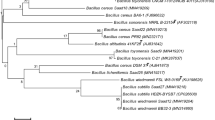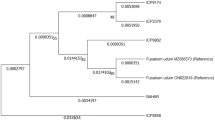Abstract
Microbiological applications in controlling plant diseases offer a powerful alternative to chemicals. The present study aimed to develop bacterial formulations with a suitable solid carrier and investigate their usability as biocontrol agents against Fusarium oxysporum f. sp. radicis-cucumerinum, which causes Fusarium root and stem rot disease in cucumber. The present study determined the antifungal efficacy of bioagent bacteria (MF-1, TV-6 F, TV-17 C, C-37 A) on Fusarium oxysporum f. sp. radicis-cucumerinum and identified using 16 S rDNA sequence analysis. Twelve formulations were created by determining pH and temperature conditions under which those bacteria grow optimally. The efficacy of formulations against the disease at different doses was tested on cucumber plants under greenhouse conditions. Also, the twelve formulations’ shelf lives were examined at room and 4 oC temperatures for six months. Using the endospores of Bacillus subtilis isolates TV-6 F, TV-17 C, and Pseudomonas chlororaphis isolates MF-1, C-37 A, the bacterial formulations were created in the range of 1.6 × 109 – 4 × 107 CFU g− 1. In general, it was determined that the antifungal efficacy of the formulations against the disease was higher than that of the synthetic seed treatment. In the shelf life studies of the formulations, bacterial counts after 6 months were found in the range of 8.9 × 109 – 9.3 × 106 CFU g− 1. The biological products developed in the present study against Fusarium root and stem rot disease in cucumber can be used as an alternative due to their significant advantages over synthetic fungicides.


Similar content being viewed by others
References
Akça A, Tozlu E (2019) The Investigatıon of Biological Control Oppurtunities Against Gray Mold Causing Botrytis cinerea Pers: Fr in Eggplant. ICOFAAS 2019, 92
Altın N (2004) Investigations on the measurements focused on biological control against fusarium wilt of cucumber (Fusarium oxysporum f.sp. cucumerinum) in greenhouse. Doctoral Thesis, Ege University
Amer GA, Utkhede RS (2000) Development of formulations of biological agents for management of root rot of lettuce and cucumber. Can J Microbiol 46(9):809–816. https://doi.org/10.1139/w00-063
Anonymous (2005) In: Halkman A (ed) Merck Gıda Mikrobiyolojisi Uygulamaları. Başak Matbaacılık Ltd. Şti, Ankara
Anonymous (2020) Study of the optimum growth conditions of Bacillus subtilis (strain WT 168), and Pseudomonas fluorescens (strain SBW25). http://2016.igem.org/wiki/images/e/e0/T--Imperial_College--ToulouseGrowthStudy.pdf. Accessed 28 October 2020
Basheer J, Ravi A, Mathew J, Krishnankutty RE (2019) Assessment of plant-probiotic performance of novel endophytic Bacillus sp. talc-based Formulation Probiot Antimicrob Proteins 11(1):256–263. https://doi.org/10.1007/s12602-018-9386-y
Bora T, Özaktan H, Göre E, Aslan EMEK (2004) Biological control of Fusarium oxysporum f. sp. melonis by wettable powder formulations of the two strains of Pseudomonas putida. J Phytopathol 152(8–9):471–475
Çakar G, Tozlu E (2022) The Biological Control of Fusarium oxysporum, the Causal Agent of Potato Rot. Gesunde Pflanzen 74:305–315. https://doi.org/10.1007/s10343-021-00610-1
Chakraborty S, Tumpa FH, Khokon Md AR (2020) Development of formulation of fluorescent pseudomonads and its evaluation on bio-management of blast of rice. Arch Phytopathol Plant Prot. https://doi.org/10.1080/03235408.2020.1826721
Demir Y, Şenol Kotan M, Dikbaş N, Beydemir Ş (2017) Phytase from Weissella halotolerans: purification, partial characterisation and the effect of some metals. Int J Food Prop 20(sup2):2127–2137. https://doi.org/10.1080/10942912.2017.1368547
Hassan E, Gökçe A (2014) Production and consumption of biopesticides. Advan Plant Biopest ed by Singh D, Springer 361–380. https://doi.org/10.1007/978-81-322-2006-0_18
İncekara R (2011) Antifungal activities of plant essential oils against cucumber root rot pathogen Fusarium oxysporum f. sp. radicis cucumerinum. Master Thesis, Mustafa Kemal University
Jamil M, ur Rehman S, Ku Lee KJ, Kim JM, Kim HS, Rha ES (2007) Salinity reduced growth PS2 photochemistry and chlorophyll content in radish. Sci Agric (Piracicaba Braz) 64. https://doi.org/10.1590/S0103-90162007000200002
Kabaluk JT, Svircev AM, Goette MS, Woo SG (2010) The use and regulation of microbial pesticides in representative jurisdictions worldwide. IOBC Global. http://www.iobc-global.org/download/Microbial_Regulation_Book_Kabaluk_et_al_2010.pdf Accessed 22 October 2020
Kalaycı Kara A, Fakıoğlu Ö, Kotan R, Atamanalp M, Alak G (2021) The investigation of bioremediation potential of Bacillus subtilis and B. thuringiensis isolates under controlled conditions in freshwater. Arch Microbiol 203(5):2075–2085
Karaca G, Kahveci E (2010) First report of Fusarium oxysporum f. sp. radiciscucumerinum on cucumbers in Turkey. Plant Pathol 59(6):1173–1174. https://doi.org/10.1111/j.1365-3059.2009.02242.x
Karagöz FP, Dursun A (2021) Calcium nitrate on growth and ornamental traits at salt-stressed condition in ornamental kale (Brassica oleracea L. var. Acephala) Ornam Hortic 27:196–203. https://doi.org/10.1590/2447-536X.v27i2.2246
Karagöz FP, Demir Y, Şenol Kotan M, Dursun A, Beydemir Ş, Dikbaş N (2021) Purification of the phytase enzyme from Lactobacillus plantarum: the effect on pansy growth and macro–micro element content. Biotechnol Appl Biochem 68(5):1067–1075. https://doi.org/10.1002/bab.2026
Khachatourians GG (2009) Insecticides, microbials. Appl Microbiol 95–109
Kotan R, Sahin F (2006) Biological control of Pseudomonas syringae pv. Syringae and nutritional similarity in carbon source utilization of pathogen and its potential biocontrol agents. J Turkish Phytopathol 35(1–3):1–13
Kotan R, Şahin F (2002) First record of bacterial canker caused by Pseudomonas syringae pv. Syringae, on apricot trees in Turkey. Plant Pathol 51(6):798–798
Kotan R, Sahin F, Demirci E, Ozbek A, Eken C, Miller SA (1999) Evaluation of antagonistic bacteria for biological control of Fusarium dry rot of potato. Phytopathology 89:41
Kotan R, Sahin F, Ala A (2004) Nutritional similarity in carbon source utilization of Erwinia amylovora and its potential biocontrol agents. J Turkish Phytopathol 33(1–3):25–38
Kotan R, Sahin F, Demirci E, Eken C (2009) Biological control of the potato dry rot caused by Fusarium species using PGPR strains. Biol Control 50:194–198. https://doi.org/10.1016/j.biocontrol.2009.04.004
Küçük C, Kivanc M, Kinaci E, Kinaci G (2007) Biological efficacy of Trichoderma harzianum isolate to control some fungal pathogens of wheat (Triticum aestivum) in Turkey. Biologia 62(3):283–286. https://doi.org/10.2478/s11756-007-0049-9
Li L, Ma J, Li Y, Wang Z, Gao T, Wang Q (2012) Screening and partial characterization of Bacillus with potential applications in biocontrol of cucumber fusarium wilt. Crop Prot 35:29–35. https://doi.org/10.1016/j.cropro.2011.12.004
Liu L, Kloepper W, Tuzun S (1995) Induction of systemic resistance in cucumber against Fusarium wilt by plant growth-promoting rhizobacteria. Phytopathology 85:695–698
Lobo CB, TomásTomas MSJ, Viruel E, Ferrero MA, Lucca ME (2019) Development of low-cost formulations of plant growth-promoting bacteria to be used as noculants in beneficial agricultural Technologies. Microbiol Res 219:12–25. https://doi.org/10.1016/j.micres.2018.10.012
Malusá E, Vassilev N (2014) A contribution to set a legal framework for biofertilisers
Martınez-Alvarez JC, Castro-Martinez C, Sanchez-Pena P, Gutierrez-Dorado R, Maldonado-Mendoza IE (2016) Development of a powder formulation based on Bacillus cereus sensu lato strain B25 spores for biological control of Fusarium verticillioides in maize plants. World J Microbiol Biotechnol 32(75). https://doi.org/10.1007/s11274-015-2000-5
Martyn RD (1996) Fusarium Wilt of Cucumber, Compendium of cucurbit diseases. In: Zitter TA, Hopkins DL, Thomas CD (eds.), Compendium of Cucurbit Diseases. APS, St. Paul, Minn, USA,15-16.
Martyn RD, Gordon TR (1996) Fusarium Wilt of Melon. In: Zitter TA, Hopkins DL, Thomas CD (eds) Compendium of Cucurbit Diseases. APS, St. Paul, Minn, USA, pp 14–15
Mohammadi P, Kotan R (2014) Biberde bakteriyel leke hastalığının etmeni xanthomonas axonopodis pv. vesicatoria’nın kontrolünde kullanılabilecek ve bitki gelişimi üzerine de etkili olan bakteriyel biyopestisitin geliştirilmesi. Türkiye V. Bitki Koruma Kongresi, Antalya, Türkiye
Mohammadi P, Tozlu E, Kotan R, Kotan M (2017) Potential of some bacteria for biological control of postharvest citrus green mould caused by Penicillium digitatum. Plant Protect Sci, 53
Mutlu G, Kırbağ S, Üstüner T (2015) Determination of Fungal Diseases in Greenhouse Cucumber in Elazığ Province. Plant Prot Bull 55(4):341–360. https://dergipark.org.tr/tr/download/article-file/712971
Ndolo D, Njuguna E, Adetunji CO, Harbor C, Rowe A, Den Breeyen A, Hospet R (2019) Research and development of biopesticides: challenges and prospects. Outlook Pest Manag 30(6):267–276. https://doi.org/10.1564/v30_dec_08
Owen JH (1956) Cucumber wilt caused by Fusarium oxysporum f. sp. cucumerinum. Phytopathology 46:153–157
Pesenti-Barili B, Ferdani E, Mosti M, Degli-Innocenti F (1991) Survival of Agrobacterium radiobacter K84 on various carriers for grown gall control. Appl Environ Microbiol 57(7):2047–2051. https://doi.org/10.1128/aem.57.7.2047-2051.1991
Posada-Uribe LF, Romero-Tabarez M, VilIegas-Escobar V (2015) Effect of medium components and culture conditions in Bacillus subtilis EA-CB0575 spore production. Bioprocess Biosyst Eng 38:1879–1888. https://doi.org/10.1007/s00449-015-1428-1
Şahinoğlu E, Tozlu E (2019) An investigation of biological control possibilities against Fusarium proliferatum on conic red pepper. 2st International Conference on Food, Agriculture and Animal Sciences (ICOFAAS), Antalya, Turkey
Senol M, Nadaroglu H, Dikbas N, Kotan R (2014) Purification of chitinase enzymes from Bacillus subtilis bacteria TV-125, investigation of kinetic properties and antifungal activity against Fusarium culmorum. Ann Clin Microbiol Antimicrob 13(1):1–7
Şenol Kotan M (2020) Development of the bacteria-content biological product effective against Fusarium oxysporum f.sp. radicis-cucumerinum. Doctoral Thesis, Atatürk University
Thakur N, Kaur S, Tomar P, Thakur S, Yadav AN (2020) Microbial biopesticides: current status and advancement for sustainable agriculture and environment. In: Rastegari AA, Yadav AN, Yadav N (eds) Trends of microbial biotechnology for sustainable agriculture and biomedicine systems: diversity and functional perspectives. Elsevier, Amsterdam, pp 243–282
Tok FM (2010) Characterization of Fusarium oxysporum isolates from melon and cucumber by pathogenicity, races, vegetative compatibility groups and aflp techniques, and their distributions. Doctoral Thesis, Mustafa Kemal University
Tozlu E, Mohammadi P, Kotan MS, Nadaroglu H, Kotan R (2016) Biological control of Sclerotinia sclerotiorum (Lib.) de bary, the causal agent of white mold disease in red cabbage by some bacteria. Plant Prot Sci 52(3):188–198. https://doi.org/10.17221/96/2015-PPS
Tozlu E, Kotan MŞ, Tekiner N, Dikbaş N, Kotan R (2019) Biological control of postharvest spoilage in fresh mandarins (Citrus Reticulata Blanco) fruits using bacteria during storage. Erwerbs-Obstbau 61(2):157–164. https://doi.org/10.1007/s10341-018-0412-8
Vakalounakis DJ (1996) Allelism of theFcu-1 andFoc genes conferring resistance to fusarium wilt in cucumber. Eur J Plant Pathol 102:855–858
Vidhyasekaran P, Muthamilan M (1995) Development of formulations of pseudomonas fluorescens for control of chickpea. Wilt Plant Dis 79:782–786. https://doi.org/10.1094/PD-79-0782
Viriyasuthee V, Saepaisan S, Saksirirat W, Gleason ML, Chen RS, Jogloy S (2019) Effective plant ages for screening for field resistance to alternaria leaf spot (caused by Alternaria spp.) under natural infection in jerusalem artichoke (Helianthus tuberosus L). Agronomy 9:754. https://doi.org/10.3390/agronomy9110754
Warra AA, Prasad MNV (2020) African perspective of chemical usage in agriculture and horticulture—their impact on human health and environment. Agrochemicals detection, treatment and remediation. Butterworth,Heinemann, pp 401–436
Zhang N, Zhao B, Zhang HJ, Weeda S, Yang C, Yang ZC, Guo YD (2013) Melatonin promotes water-stress tolerance, lateral root formation, and seed germination in cucumber (Cucumis sativus L). J Pineal Res 54:15–23
Acknowledgements
The authors would like to thank the Scientific and Technological Research Council of Turkey (TUBITAK) for their financial support. We would like to thank Assoc. Prof. Elif Alper Tozlu from Atatürk University Faculty of Agriculture, Department of Plant Protection, for her valuable contributions.
Funding
This work was supported by the Scientific and Technological Research Council of Turkey (TUBITAK) (Grant Numbers 119O542).
Author information
Authors and Affiliations
Contributions
M.Ş.K. conducted the experiments, recorded and processed the data, designed tables and graphs, prepared the draft manuscript, and revised and edited the final manuscript. R.K. designed the overall study. N.D., M.Ş.K, and R.K. developed and, discussed, and interpreted the results.
Corresponding author
Ethics declarations
Conflict of interest
The authors declare that they have no conflict of interest.
Ethical approval
This article contains no studies involving human participants performed by any authors.
Consent to participate
Informed consent was obtained from all individual participants included in the study.
Consent for publication
Informed consent was obtained from all individual participants included in the study.
Additional information
Publisher’s Note
Springer Nature remains neutral with regard to jurisdictional claims in published maps and institutional affiliations.
Electronic supplementary material
Below is the link to the electronic supplementary material.
Rights and permissions
Springer Nature or its licensor (e.g. a society or other partner) holds exclusive rights to this article under a publishing agreement with the author(s) or other rightsholder(s); author self-archiving of the accepted manuscript version of this article is solely governed by the terms of such publishing agreement and applicable law.
About this article
Cite this article
Şenol Kotan, M., Dikbaş, N. & Kotan, R. Solid carrier bacterial formulations against Fusarium root and stem rot disease in cucumber. J Plant Pathol 106, 153–163 (2024). https://doi.org/10.1007/s42161-023-01530-x
Received:
Accepted:
Published:
Issue Date:
DOI: https://doi.org/10.1007/s42161-023-01530-x




